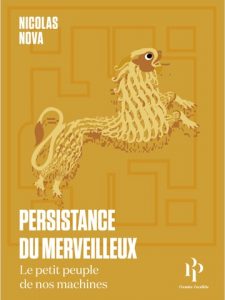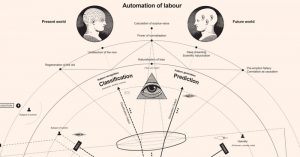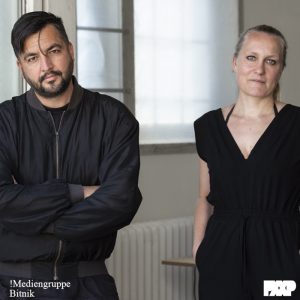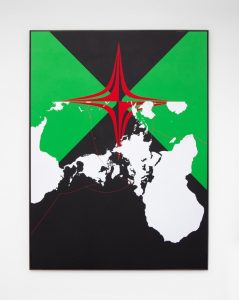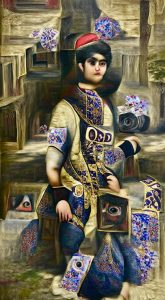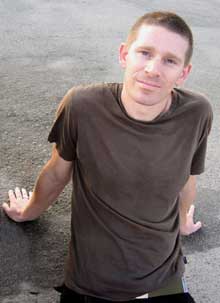 Andy Gracie creates digital artworks that invite technological sytems to dialog with natural living systems or phenomena. Andy investigates what takes place at the point where these two systems are mediated through each other and what kind of new communication can develop between these different entities. The techniques used and areas explored in his work are rooted in science, but his practice is also poetical and humorous.
Andy Gracie creates digital artworks that invite technological sytems to dialog with natural living systems or phenomena. Andy investigates what takes place at the point where these two systems are mediated through each other and what kind of new communication can develop between these different entities. The techniques used and areas explored in his work are rooted in science, but his practice is also poetical and humorous.
I met him in April at a music festival in Barcelona. He told me that evening “Hey, you wrote about one of my Hostprods works on your blog.” I tried not to look as the one who forgets an art piece one month after having written about it. Not sure i managed to but as he had eyes only for his baby, i guess he didn’t mind. I went back to the hotel, googled his name and gosh! nooo! Not only did i remember his work but i also like it a lot. It was too late to chat with him. So here’s my latest attempt to make him talk about his work:
What’s your background? How did you get interested in art forms that investigate technological and natural systems?
My background is actually very traditional. I did a degree in fine art at Liverpool Polytechnic many, many years ago, specialising in painting and sculpture. However, towards the end of my studies I became aware of installation and performance as art forms and was excited and intrigued by the possibilities they offered. I had always leaned towards making my work participatory or immersive in some way but within the bounds of what I thought was just ‘ordinary’ fine art practice. To cut a long story short I then spent some time traveling and training as a trapeze artist before coming back to being an artist and setting up a short lived aerial performance company. All my work in these performances or in my embryonic installations featured some element of sound – tape loops, electronics, or whatever and I eventually realised that the possibilities offered by the technology that I, or whoever else, was using was what really excited me. All this led me to invest in my first ‘real’ technology – a Mac 5320, an I-Cube and an early edition of Max/Msp – there was no going back!
After spending some time making various immersive and/or interactive sound environments I made a piece using signals from a total eclipse of the Sun to generate data for audio generation and control. A ‘probe’ device gathered readings from the sun and atmosphere, converted it to MIDI and broadcast it on the interent along with real-time VLF audio so that others could jam along. The data, VLF recordings and another probe device evolved into ‘Positron Array’ an installation commissioned by DigitalSummer in Manchester and a realisation that technology combined with data mining and observation of natural phenomena was something rich, exciting and full of potential.
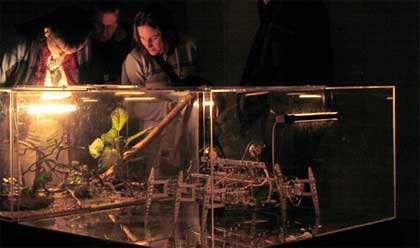 small work for robots and insects (second version)
small work for robots and insects (second version)
A slightly later piece I made was the first version of small work for robot and insects which was originally a small commission to make a sound installation. Devoid of any ideas at the time I was flicking around some of my sketchbooks and discovered various scribblings I had made about robots and insects interacting, or of roaming robots behaving as field sound recordists monitoring the sounds of various species and sending the information back to other robots or installation environments. I think that making this piece was when it really clicked for me in terms of the examination and manipulation of relationships between the synthetic and the natural that I am now investigating. The second version of the piece which saw the beginning of my work with Brian Lee Yung Rowe and the introduction of AI to enable the machinic elements of these networked ecologies to operate in a more symbiotic or parasitic way was a significant development.
Your art pieces require to have knowledge of different disciplines robotics, biology, AI… Are you an autodidact? Do you rely on the cooperation of other experts or artists?
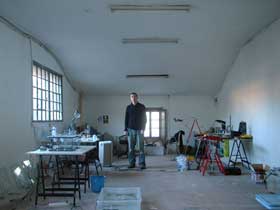
I am, for the most part, an autodidact… but only to a point. I have taught myself to a certain functional level in things such as programming, electronics, biology, robotics, engineering and so on. The work I want to make demands a much higher level of finesse or expertise in one or more of these fields than I am capable of alone and I am fortunate to have had the help of a variety of more talented people than myself. It would be difficult to make a full list here but special mentions must go to Gary Burns who has been invaluable with his in depth knowledge and flair with electronics and to Brian Lee Yung Rowe with his skills in AI and other programming. I also do some teaching on multimedia and digital arts courses at Huddersfield University as well as being a member of a research group there which provides a constantly stimulating environment and access to the brains of a diverse and talented bunch of brains ripe for the picking.
The knowledge that I have of all the disparate elements of the work allows me to create a meaningful overview of the projects I’m working on and to have a good foundation for the necessary speculation involved in creativity. An understanding of biological and other scientific developments and practices, for instance, is absolutely vital to my working method and many hours of my time are consumed by keeping up to date. In any event, I consider the act of self-teaching through trial and error, in depth study, hands-on reasearch or any other approach to be absolutely necessary to any artistic practice.
I use the name hostprods as a way of acknowledging that there is a group contribution to the work that appears under my own name.
You’re collaborating with Brian Lee Yung Rowe on the Phumox project. Phumox explores collective intelligence, organic development and interplay with the dual concepts of symbiosis and parasitism. What does Phumox bring to the Hostprods research? How do you and Brian Lee Yung Rowe complement each other? Different expertise?
Brian and I complement each other? Never!
Phumox exists to embody a specific area of hostprods research and as a vehicle for Brian and myself to collaborate on all aspects of a project rather than just the programmer – artist relationship of other works. I want the Andy Gracie (hostprods) stuff to be able to have a little more freedom, not to be bound to a particular methodology or concept so Phumox serves to liberate hostprods while at the same time providing a focus for work pertaining to large and complex artificially intelligent networked ecologies such as ‘autoinducer pH_1’. Obviously, there is no clean cut between the two and things will bleed from one to the other – hostprods research will rear its head in Phumox and Phumox ideas may appear in other guises in hostprods.
Actually, it has been interesting to have had the experience of working with Brian in different ways. In other works there has basically been an AI shaped gap that Brian’s programmes have more than adequately filled and even though we may have brainstormed together at some point the work has basically been mine. In Phumox we work together 50/50 with no distinction between artist and programmer, we make the work from conceptual development onwards together. We have a very different approach to making work which can sometimes be stimulating, sometimes exciting, sometimes really annoying but more often that not very productive. Brian is very rigorous, I am very trial and error.
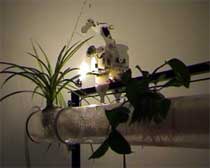
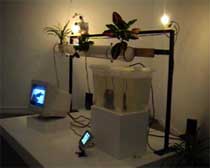 Fish, plant, rack
Fish, plant, rack
Which conclusion did you draw from a piece like Fish, plant, rack, an installation that examines the relationship between a fish, a robot and plants? Anything unexpected happened?
I don’t think I actually draw any concrete conclusions from my work, I don’t think there are any conclusions – just more questions and more opportunities for reflection.
Unexpected things always happen as the work embodies notions of emergence. When I make the work I give the system as a whole the potential to behave in certain ways, to be riddled with possibilities. The added involvement of unpredictable organic intelligences puts paid to any chance of defining the ongoing behaviour of the system, especially as they are normally the driving force for the evolutionary behaviours of the mechanical elements of the work. It’s an exciting feeling to know that when I leave my work after an install I never know what kind of things it will be getting up to when I return to take it down and that the longer the piece is exhibited the more unpredictable will be its behaviour.
Fish, plant, rack was especially interesting for me though because it was a definite progression from small work for robot and insects in that the bio-artificial ecosystem was more complex and so richer in potential and permutations. In this piece the data was going though a range of organic and synthetic processors – fish to computer to robot to plants to robot to fish, so it’s a bit like a game of chinese whispers in that you never know what is going to come out the other end. These kind of works exhibit forms of closed system feedback loop that are very common in ecological, biological and social systems.
Do you think that your work could be understood and appreciated by the scientific community? How?
I would be happy for that to be the case but so far it hasn’t happened. When autoinducer was shown earlier this year I received a report of a visit from a very unhappy biologist who was visiting the show. Apparently he was upset that the information he wanted was not available to him, that the system wasn’t displaying clearly every piece of data he wanted to see and that the species involved weren’t clearly labelled. Basically he was unhappy that the piece wasn’t presented as a scientific experiment and concluded that it therefore failed as art and as science. He was entitled to his opinion, of course, but his scientific approach to the work prevented him from appreciating what it was really about.
My work is full of ambiguities, some intentional and some unavoidable, and often takes a playful or challenging stance on the science that has enabled it to be made. It aims to force us to reconsider what science has told us and what science is, to re-evaluate or personal position with regard to science and to realise that it is not as esoteric as some would have us believe. This seems to be a problem for many scientists.
I’m not really sure what having my work understood and appreciated by the scientific community would actually achieve though. It’s certainly not going to force them to reconsider the meaning of science and the world about us, and its not going to make any advancement in scientific knowledge. As I have mentioned, my work is strongly based in scientific knowledge and I do an enormous amount of research to ensure that it has a solid basis in theory and practice, however it is not made as scientific experiment and I make no form of quantative analysis at the end of each exhibition.
Having said all that, I do have a good relationship with a small number of scientists who understand what I am trying to do, but I’m not sure if they agree that an artform such as mine is particularly valid.
What can we (the man on the street or the scientist) learn from InterSpecies Communication?
I’m not sure if I agree that learning is an appropriate term for the appreciation of art, and I’m certainly not trying to teach anyone anything. But to try to answer the question maybe we can improve our perception of the interconnectedness of all things. That the whole of evolution and the diversity of life is based on the exchange of information (and even parts) between organisms and environments. That the nature of all ecologies is networked and becoming more and more infused with the synthetic and the machinic. I have heard of some people describing ‘InterSpecies Communication Art’ as a new movement or art form but I’m not sure if I really go for that. My work involves cross species data transfer but only as an element in a broader networked system.
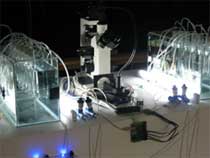
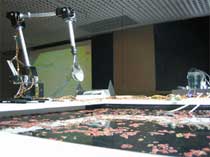 Autoinducer_Ph-1 (cross cultural chemistry)
Autoinducer_Ph-1 (cross cultural chemistry)
What were you trying to achieve with the bio-artificial rice growing system called Autoinducer_Ph-1 (cross cultural chemistry)?
Autoinducer grew out of the idea of Brian and myself making a fully collaborative piece of work and the concept was borne out of conversations about our cultures and obsessions. We wanted to see if we could create a fully functioning symbiosis between an organic life form and a synthetic one and to allow that symbiosis to generate information that could be harnessed to drive other processes.
Brian also wanted to try out some of his newer experiments in AI, or to be more precise Synthetic Biology, which he called the Generalized Cellular Signalling system. Basically, this system allows units of code to be born, live, interact and die in the same way as organic cells or bacteria (an autoinducer is the chemical used by cells to carry information to other cells, an organic FedEx). GCS was the ideal software environment to hook up to an organic system and the Anabaena / Azolla symbiosis presented itself as an ideal practical and cultural phenomenon with which to develop the piece.
Conceptually we wanted to create discussion about the methods by which our food is prepared in the modern world, how much of an automated factory-style process is involved even in agriculture, and to counterpoint that with ancient organic approaches. The piece also extended our cultural metaphor of the bio-artificial ecosystem, a complex, exposed negotiation and mediation between a number of organic and synthetic elements.
We had also hoped that by the end of the exhibition period the system would have grown enough rice to make a meal for all the people involved with setting up the work… we learnt that better lighting, more time and higher temperatures might be necessary next time.
You are English but also spend time and work on projects in Barcelona. Do you think that Barcelona is a fertile ground for interactive/new media art or bioart works? How is the scene over there?
There is a lot of very interesting interactive and new media work happening in Barcelona. The Dorkbot meetings are always well attended and always feature fascinating projects. People like Alex Posada who is now working a lot at Hangar are doing fantastic work and supporting a new wave of interesting projects. There seems to be a lot of work going on with the concepts of DIY and open source with a lot of work being done via the web. I would say that artists in Barcelona, and Spain in general, have to be a lot more resourceful than British artists as they get much less support.
On the other hand there is nothing notably ‘bio’ going on, apart from my own work (which I don’t really consider to be ‘bio-art’ anyway). Fortunately there is a curator / organizer / researcher here called Monica Bello who is pioneering some really interesting projects and exhibitions that examine the nature of the relationships between art and the sciences with an emphasis on the biological sciences. She actually commissioned ‘fish, plant, rack’ for her exhibition ‘Organismos: esto es vida’. Her work is absolutely vital in light of Catalunya and Barcelona becoming a new European Biocluster and investing huge sums of money in new facilities and bioscientific research.
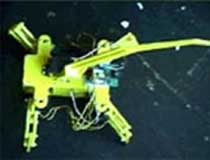
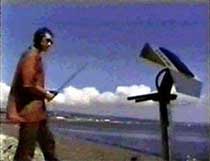 samplebot and positron array
samplebot and positron array
How do you finance your art works? Do you rely on grants? Commissions? Side jobs?
I would love to be able to say I just work in my light, spacious and fully equipped studio 14 hours a day and make more money than I need as an artist. The truth is that the finance comes from a number of less glamorous sources. The majority of my day-to-day research and living is funded by the teaching I do at the University of Huddersfield, the occasional workshop, lecture or presentationand no little manual labour (I’m currently working for a small long distance removal company a few days each month…).
Larger projects can be financed in a number of ways – sometimes I will receive a commission to make a new piece for a new exhibition and this is the best way to make work as far as I am concerned. If I want to carry out a particular research project or make an experimental work I am lucky enough to receive the occasional grant. I’m indebted to the Arts Council for the support they have given me over the last few years and to a number of people who have commissioned works. Basically, the majority of the work I make is so complex and expensive to realise that it doesn’t really happen without some financial machinery of one description or another swinging into action.
What projects are you currently working on?
Currently I am trying to find a way to continue a meaningful artistic career while having an 11-month-old son! It’s the biggest challenge I’ve faced so far.
There is no one particular piece in development at the moment but I am researching further into bacteriology, nanotechnology and video microscopy. I can lose hours watching protozoa swimming around under my microscope but I’m not entirely sure what to do with them just yet. I’d like to make some smaller, simpler pieces or multiples that will express similar emergent networked behaviours as the larger pieces of the last few years.
I just got back from a very exciting research visit to Japan and there are some interesting possibilities for collaboration over there as well. I’d love to do a residency and make a new work over there, the Japanese cultural relationships with nature and technology are particularly fascinating.
The trip was part of the activities of the Pylon project that i have been involved with for a while. Pylon is a small group of artists sharing resources and a project development manager and enables a collective approach to marketing, research and networking, without compromising the identity or integrity of our solo practices. It’s been a very beneficial experience for me in many ways.
I have a solo exhibtion of fish, plant, rack in Ljubljana in mid-November and will be presenting a paper at Article in Stavanger, Norway just after that.
Oh, and I’m doing an interview for We Make Money Not Art.
Thanks Andy!

